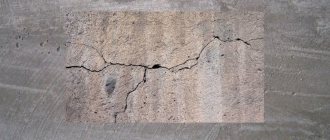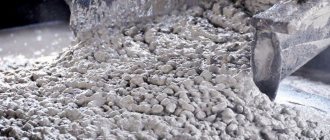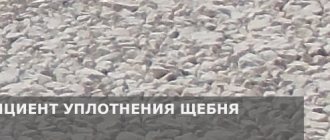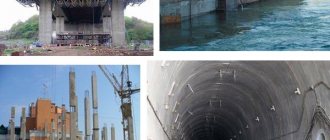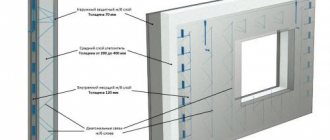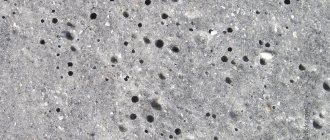Concrete is a building mixture of cement, inert materials and water. When it hardens, the mass turns into stone. Hardening occurs due to internal processes of crystallization and evaporation of water.
As a result, the volume of the monolith changes, and it is also necessary to take into account the shrinkage coefficient of concrete. The value depends on the brand of cement, the fluidity of the dough and the method of compaction.
Factors that cause concrete shrinkage
During the hardening of the concrete mass, physical and chemical processes occur in it that change the structure. Shrinkage is a consequence of these changes. It continues during and after the concrete hardens, which must be taken into account when creating structures.
Types of processes leading to concrete shrinkage during drying:
- removal of moisture;
- carbonization;
- contraction shrinkage.
It has been established that cement has a granular base and water penetrates deeper gradually, forming hydrosilicates. Hydration requires a long period of weeks. At this time, water evaporates from the surface layer, and shrinkage cracks appear, reducing the strength of concrete. Evaporation of moisture from the inner layers occurs if the capillaries between the grains are less than 0.1 microns.
Contraction shrinkage is the tightening of a mass as a result of hydration. Occurs in fresh concrete due to the formation of calcium hydrogel.
Carbonation is the chemical reaction Ca(OH)2 + CO2 = CaCO3 + H2O. The result is limestone, and water is displaced through capillaries. The material is compacted, which leads to air shrinkage of the concrete.
The reduction in linear dimensions continues for up to one and a half years, which should be taken into account during construction. To stabilize the process and reduce the shrinkage time of concrete, the mass is reinforced, increasing the strength qualities of the monolith. At the same time, a mixture with additives is used, pouring the mass under pressure with vibration to reduce shrinkage to negligible.
Primary and secondary stages
As established by practice, there are 2 stages:
- primary, when it is still in a plastic or liquid state, which is caused by moisture leakage through the formwork, absorption of moisture by it, or absorption of moisture by the base of the road in road construction, as well as evaporation;
- secondary, which occurs when it dries and hardens.
Floor structure diagram.
The amount of initial shrinkage before it sets depends both on the care system and on the degree of water absorption by the base or formwork. Therefore, it can be reduced by carrying out these activities.
The secondary occurs during hardening, due to shrinkage of the cement gel. It is a partially irreversible process, since upon subsequent moistening the concrete expands, but this sample will not be able to reach its original volume. With further drying or wetting, expansion and shrinkage are practically reversible. If it is immersed in water for a long time after installation, it will expand slightly, but after drying, the deformation will be the same as before.
Concrete shrinkage coefficient
The indicator determines by what percentage the initial volume or linearity of the structure is reduced during the period allotted for strength gain. The permissible shrinkage of concrete according to GOST 24544-81 is up to 3%, the average is about 1.5%.
The indicator is determined by summing up the periods of mass hardening and strength gain.
- Plastic shrinkage of concrete when pouring, 4 mm/m
- Autogenous shrinkage - the first week, “young” concrete shrinks by 1 mm/m.
- Concrete shrinks during the year up to 5mm/m.
Linear dimensions when summed and converted into volumetric ones are established for different grades of concrete. Based on the tests, the concrete shrinkage coefficient is regulated in GOST.
Calculation of the mixture needs taking into account concrete shrinkage is carried out using the formula V=H*S*K, where:
- V – product volume,
- S – surface area,
- Kus is the shrinkage coefficient of concrete.
The accepted coefficient is 1.1. This means that the consumption of concrete solution is 10% more than the volume of the finished product, taking into account losses and shrinkage.
Deformation
Thanks to the use of additives, it is possible to reduce bending elongation and permeability, and eliminate deformations. The specific type and volume of additives are determined individually.
Primary and secondary stages
Main types
Reasons for education
Heavy types shrink less than light ones (they are porous and shrinkage can reach 1 centimeter per meter). The rule works here: the smaller the filler elements, the less shrinkage the solution prepared on its base will produce.
Ways to reduce shrinkage
You can prevent rapid drying of the top layer of concrete by periodically wetting the surface. At a temperature of 20-30 degrees and air humidity of 90%, the surface hardens without cracking. This requires moistening the surface or heating the plate in a steam environment.
Concrete shrinkage rates are reduced if used in a batch:
- expanding cements;
- additives to concrete that compensate for shrinkage;
- reduce cement content;
- reduce sand content.
The knead should be plastic, but contain a minimum amount of water. For this purpose, special additives and expanding Portland cements of the OBTC and BTC brands are used.
Shrinkage of concrete during hardening can be reduced by introducing plasticizers, adding lime, aluminum salts, and reinforcement, but it cannot be completely eliminated. The introduction of porous fillers reduces the indicator by 2.5 times. Forming using vibration compaction reduces the amount of concrete shrinkage by 0.6-0.8%.
Why does it happen?
The appearance is associated with the evaporation of water in the cement composition, in which an important role is given to the action of capillary forces in the structure of the mixture. As a result of their narrowing, the product becomes denser, and this causes shrinkage. The role of moisture in this is the main one, and its appearance depends not only on environmental conditions, but also on the characteristics of the cement used for mixing. A high drying rate is only possible if there is a large amount of aluminates in the material. And to reduce this parameter, alite cements are used. Consequently, concrete shrinkage is associated with the following factors:
- weather;
- quantitative indicators of the components of the solution;
- volume of moisture;
- the presence of reinforcing elements.
How to calculate the shrinkage of concrete in a batch
Laboratory tests make it possible to determine the fluidity of the mass and its shrinkage. The main methods are to deposit concrete in a cone and test a standard cube after hardening. The fluidity of concrete is the ability of the composition to spread when compacted with a vibrator, filling voids.
The indicator is standard, denoted by the letter “P” and the letter 1,...5. The higher the flow coefficient, the more water in the batch. For monolithic filling, mixtures P1, P2, P3 are used. They are prepared locally, the concrete is hard and sets quickly. Only P4 and P5 are delivered in a concrete truck.
The determination of “P” is carried out with a container in the form of a truncated cone with a volume of 6 liters and a height of 30 cm. It is determined how many cm the concrete has dropped after the cone has been removed from it.
Cone shrinkage flow table
| Indicator "Mobility" | Sample shrinkage, mm |
| P1 - sedentary | 10-50 |
| P2 - sedentary | 50-100 |
| P3 – general purpose concrete | 100-150 |
| P4 - highly mobile | 150-200 |
| P5 - highly mobile | >200 |
The study of a cube-monolith serves for more in-depth studies with accurate measurements of shrinkage. But the larger the number P, the greater the shrinkage, this is a regularity. By the shrinkage of concrete in the cone, you can judge how much the mass will settle when pouring the foundation, and calculate the required volume of solution.
Losses from settlement of concrete mixture
If builders did not notice the shrinkage in time, this is fraught with serious consequences. When vibration shaking of the mixture was not used, this condition will cause it to shrink by several centimeters. Moreover, this process proceeds unevenly and threatens to distort the building, which causes cracks in the walls.
Concrete can shrink when exposed to external vibrating processes. The reason for this is the abundance of air that gets inside the solution due to a faulty concrete mixer or other mixing tool. Construction practice shows that this phenomenon occurs very often.
Shrinkage joints in monolith
When pouring a monolithic slab or tape, it is necessary to make shrinkage joints. Small gaps cut into the body of the slab allow creating conditions for uniform shrinkage, without breaking the monolith. Break lines are drawn according to rules confirmed by calculation of concrete shrinkage.
The screed map is made up of squares or rectangles with an aspect ratio of 1:1.5. The lines must be without bends. The cutting distance is selected based on permissible temperature changes.
Indoors, seams are created every 6 meters, in an open area no more than 3 * 3 m. For paths, a distance of 3.6 m is sufficient. The seam does not cut through the entire thickness of the monolith, it is 1/3 or 1/4 of the thickness of the screed.
If the monolith represents a strong foundation, then drilling with a drill with a diamond attachment is used, which does not destroy the walls and cuts through the concrete like a knife through butter.
Preliminary calculation formulas for different types of foundation
When choosing a method for calculating the volume of concrete, you need to know the type of foundation and have its exact geometric calculations:
- For a slab (“floating slab”) foundation, it is enough to know the building area and slab thickness, which are multiplied to obtain the volume of the casting. In cases where the foundation has additional stiffeners, then it is necessary to find the volume of each stiffener and add them to the total volume of the slab.
- The pile foundation has the widest range of applications, because... Thanks to weight distribution and reliable installation of piles, it is possible to successfully erect structures on complex heaving soils. Calculation of concrete for a pile foundation is a calculation of the volume of one column multiplied by their number. The most problematic thing in the calculation is calculating the volume of the pile, because the shape can be different: a parallelepiped, a simple cylinder, with a fifth at the base, which can be cylindrical, cubic or conical. For simple cylindrical piles, the volume calculation is very simple: the area of the circle (3.14*R^2, where R is the radius of the pile, half its diameter) of the base of the pillar is multiplied by its height.
- Strip foundations are very popular due to their ease of manufacture and calculation. To know how to calculate concrete for a foundation of this type, it is necessary to “virtually” divide it into separate “walls”, the volume of which is calculated by multiplying the height, width and length. Knowing the volume of each side of the foundation, the total volume of concrete required is determined by their addition.
- There are also more complex types of foundations (combined). Their volume is calculated by summing the volumes of individual sections of the structure. In this case, remembering a geometry course to calculate various figures will help.
Concrete maturation standards
As soon as the cement comes into contact with water, the reaction begins to form a hydrogel - a binder. The period of plastic shrinkage lasts 8 hours, starting from mixing. Therefore, the rigid mixture is laid immediately, and highly mobile trains are made for delivery over a distance.
Within 7 days, hydration in the concrete mass is completed and limestone crystals form. 70% strength is gained. After 28 days, the concrete solution should turn into a monolith, meeting 100% strength requirements.
Preventive actions
To avoid obtaining low-quality concrete and a high shrinkage rate, several important rules must be followed:
Change in the coefficient of transverse deformation of concrete during eccentric compression testing.
- do not use low grade concrete for the construction of residential buildings,
- use a metal frame to strengthen concrete,
- knead under optimal conditions,
- maintain proportions when preparing the working solution,
- process the mixture with a vibrator,
- provide the necessary moisture to the surface of the material.
Particular attention must be paid to specially added additives. If we evaluate the importance of all components of concrete, then water and fillers play the greatest role in obtaining the desired shrinkage coefficient. Often, when carrying out complex and voluminous construction work, concrete based on special additives is used. Otherwise, such mixtures are called with compensated shrinkage. Additives added to the solution contribute to its expansion, as a result of which the coefficient under consideration is reduced and the risk of cracking is reduced.
Return to contents
What is precipitation
Even the best quality concrete is prone to settling. It is impossible to completely avoid this phenomenon. Concrete shrinkage is a phenomenon in which the poured mass changes its size and configuration during the setting process. During this process, the concrete is compacted and hardened. It is of great importance that the intensity and magnitude can be influenced by factors of physical and chemical nature.
Setting of concrete, depending on its brand and the presence of special additives, occurs within several tens of minutes or hours. Why is it necessary to determine the possible amount of concrete shrinkage during construction work?
The answer is quite simple. This is necessary in order to correctly calculate the thickness of the concrete. The latter is used mainly for pouring foundations, building roads, and concrete paths. In all cases, the poured surface must have a certain thickness and shape. The strength and durability of the structure depends on this. Due to all this, calculating the sedimentation coefficient is necessary in order to correctly pour concrete. In this case, it should be with a reserve. The calculated and actual thickness and shape of concrete must match. Otherwise, the excess concrete will not be easy to remove, and the deficiency will be difficult to fill.
Cement volume
The total volume of active substances in cement always decreases as it sets and hardens. This is due to the fact that the water molecules included in calcium hydroaluminates and hydrosilicates are located much closer to each other than when they are in a free state.
The initial volume of cement paste is calculated by the formula:
After reducing this volume during hydration, it should be calculated using the formula:
C-Cg + (Cg + Br)K + B-Br+v = = C + B + v - (1-K)(Cg + Br),
Tsg – volume of hydrated cement;
Wg – water of hydration;
c – air volume;
K is a coefficient that should be less than one; this coefficient is the ratio of the increase in the specific gravity of crystalline formations to the average specific gravity of the materials that contributed to the formation of these crystals.
Considering all of the above, we can conclude that the entire hardening process consists of constant compression of the grains of crystalline new formations. This contraction creates an overall decrease in the volume of cement, which is called "concrete shrinkage."
